PPMP20009: Lean Project Management Implementation Memo
VerifiedAdded on 2023/03/21
|14
|3428
|99
Report
AI Summary
This report focuses on the implementation of Lean Project Management (LPM) principles within a project consultancy organization aiming to secure government projects. The report begins with an introduction to LPM, its five key steps (client collaboration, project planning, execution, progress monitoring, and post-project review), and the overall memo's objective. It highlights the initial reasons for implementing LPM, emphasizing its benefits such as client protection, new business opportunities, cost predictability, risk management, and enhanced value delivery. The report details the five core LPM principles: specifying customer value, identifying value streams, eliminating waste, customer-driven flow, and striving for perfection. It then explores the benefits of LPM for both internal and external stakeholders, particularly the government, including improved product quality, cost efficiency, employee efficiency, and profit margins. The report also outlines critical success factors (CSF) for LPM implementation, such as accessibility, value stream management, flow, multi-skilled teams, transparency, and process control. The report concludes by emphasizing the importance of training and appropriate implementation steps, ensuring the project's sustainability, cost-effectiveness, efficiency, and effectiveness. The report references various academic sources to support its claims.
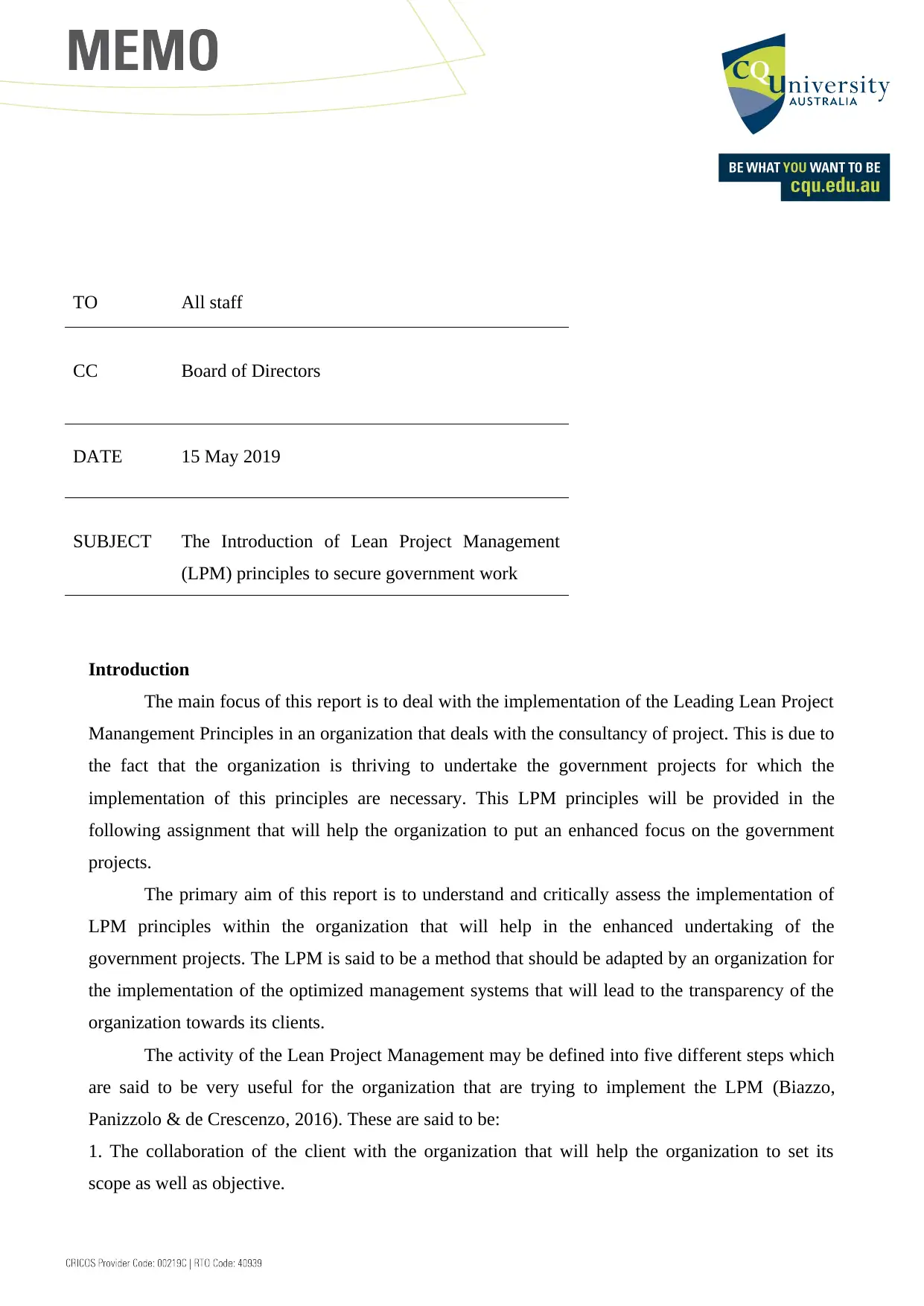
Introduction
The main focus of this report is to deal with the implementation of the Leading Lean Project
Manangement Principles in an organization that deals with the consultancy of project. This is due to
the fact that the organization is thriving to undertake the government projects for which the
implementation of this principles are necessary. This LPM principles will be provided in the
following assignment that will help the organization to put an enhanced focus on the government
projects.
The primary aim of this report is to understand and critically assess the implementation of
LPM principles within the organization that will help in the enhanced undertaking of the
government projects. The LPM is said to be a method that should be adapted by an organization for
the implementation of the optimized management systems that will lead to the transparency of the
organization towards its clients.
The activity of the Lean Project Management may be defined into five different steps which
are said to be very useful for the organization that are trying to implement the LPM (Biazzo,
Panizzolo & de Crescenzo, 2016). These are said to be:
1. The collaboration of the client with the organization that will help the organization to set its
scope as well as objective.
TO All staff
CC Board of Directors
DATE 15 May 2019
SUBJECT The Introduction of Lean Project Management
(LPM) principles to secure government work
The main focus of this report is to deal with the implementation of the Leading Lean Project
Manangement Principles in an organization that deals with the consultancy of project. This is due to
the fact that the organization is thriving to undertake the government projects for which the
implementation of this principles are necessary. This LPM principles will be provided in the
following assignment that will help the organization to put an enhanced focus on the government
projects.
The primary aim of this report is to understand and critically assess the implementation of
LPM principles within the organization that will help in the enhanced undertaking of the
government projects. The LPM is said to be a method that should be adapted by an organization for
the implementation of the optimized management systems that will lead to the transparency of the
organization towards its clients.
The activity of the Lean Project Management may be defined into five different steps which
are said to be very useful for the organization that are trying to implement the LPM (Biazzo,
Panizzolo & de Crescenzo, 2016). These are said to be:
1. The collaboration of the client with the organization that will help the organization to set its
scope as well as objective.
TO All staff
CC Board of Directors
DATE 15 May 2019
SUBJECT The Introduction of Lean Project Management
(LPM) principles to secure government work
Paraphrase This Document
Need a fresh take? Get an instant paraphrase of this document with our AI Paraphraser
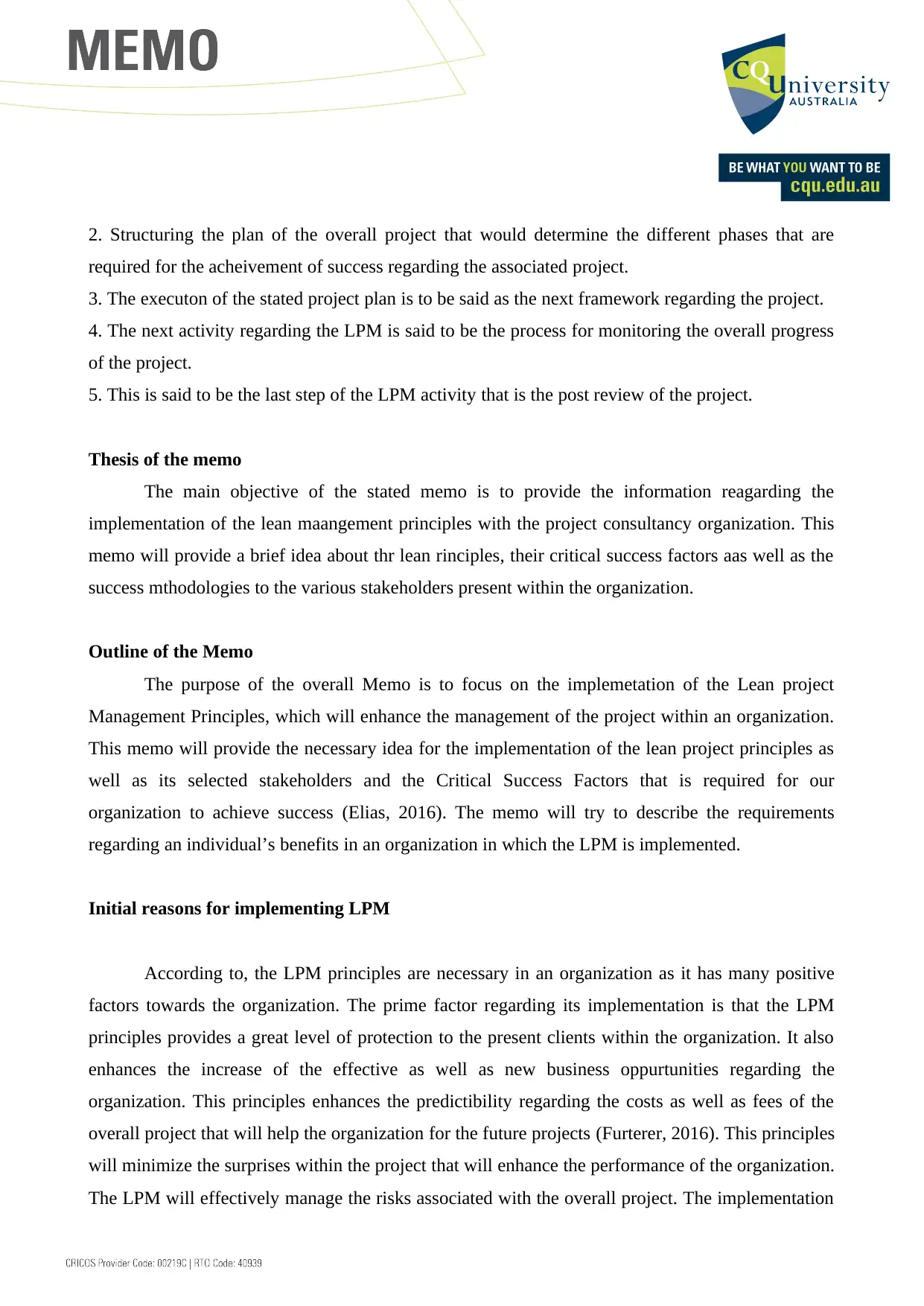
2. Structuring the plan of the overall project that would determine the different phases that are
required for the acheivement of success regarding the associated project.
3. The executon of the stated project plan is to be said as the next framework regarding the project.
4. The next activity regarding the LPM is said to be the process for monitoring the overall progress
of the project.
5. This is said to be the last step of the LPM activity that is the post review of the project.
Thesis of the memo
The main objective of the stated memo is to provide the information reagarding the
implementation of the lean maangement principles with the project consultancy organization. This
memo will provide a brief idea about thr lean rinciples, their critical success factors aas well as the
success mthodologies to the various stakeholders present within the organization.
Outline of the Memo
The purpose of the overall Memo is to focus on the implemetation of the Lean project
Management Principles, which will enhance the management of the project within an organization.
This memo will provide the necessary idea for the implementation of the lean project principles as
well as its selected stakeholders and the Critical Success Factors that is required for our
organization to achieve success (Elias, 2016). The memo will try to describe the requirements
regarding an individual’s benefits in an organization in which the LPM is implemented.
Initial reasons for implementing LPM
According to, the LPM principles are necessary in an organization as it has many positive
factors towards the organization. The prime factor regarding its implementation is that the LPM
principles provides a great level of protection to the present clients within the organization. It also
enhances the increase of the effective as well as new business oppurtunities regarding the
organization. This principles enhances the predictibility regarding the costs as well as fees of the
overall project that will help the organization for the future projects (Furterer, 2016). This principles
will minimize the surprises within the project that will enhance the performance of the organization.
The LPM will effectively manage the risks associated with the overall project. The implementation
required for the acheivement of success regarding the associated project.
3. The executon of the stated project plan is to be said as the next framework regarding the project.
4. The next activity regarding the LPM is said to be the process for monitoring the overall progress
of the project.
5. This is said to be the last step of the LPM activity that is the post review of the project.
Thesis of the memo
The main objective of the stated memo is to provide the information reagarding the
implementation of the lean maangement principles with the project consultancy organization. This
memo will provide a brief idea about thr lean rinciples, their critical success factors aas well as the
success mthodologies to the various stakeholders present within the organization.
Outline of the Memo
The purpose of the overall Memo is to focus on the implemetation of the Lean project
Management Principles, which will enhance the management of the project within an organization.
This memo will provide the necessary idea for the implementation of the lean project principles as
well as its selected stakeholders and the Critical Success Factors that is required for our
organization to achieve success (Elias, 2016). The memo will try to describe the requirements
regarding an individual’s benefits in an organization in which the LPM is implemented.
Initial reasons for implementing LPM
According to, the LPM principles are necessary in an organization as it has many positive
factors towards the organization. The prime factor regarding its implementation is that the LPM
principles provides a great level of protection to the present clients within the organization. It also
enhances the increase of the effective as well as new business oppurtunities regarding the
organization. This principles enhances the predictibility regarding the costs as well as fees of the
overall project that will help the organization for the future projects (Furterer, 2016). This principles
will minimize the surprises within the project that will enhance the performance of the organization.
The LPM will effectively manage the risks associated with the overall project. The implementation
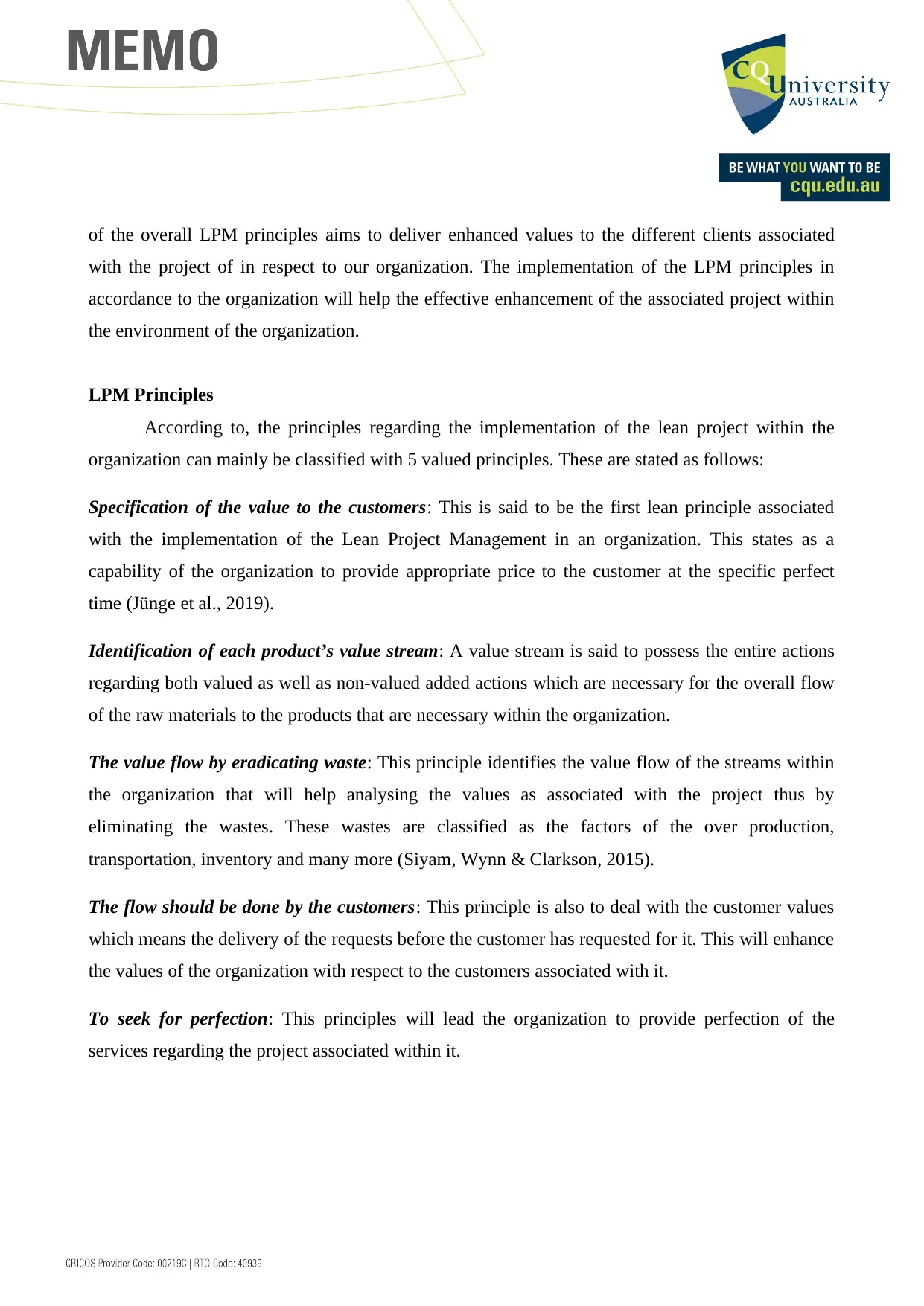
of the overall LPM principles aims to deliver enhanced values to the different clients associated
with the project of in respect to our organization. The implementation of the LPM principles in
accordance to the organization will help the effective enhancement of the associated project within
the environment of the organization.
LPM Principles
According to, the principles regarding the implementation of the lean project within the
organization can mainly be classified with 5 valued principles. These are stated as follows:
Specification of the value to the customers: This is said to be the first lean principle associated
with the implementation of the Lean Project Management in an organization. This states as a
capability of the organization to provide appropriate price to the customer at the specific perfect
time (Jünge et al., 2019).
Identification of each product’s value stream: A value stream is said to possess the entire actions
regarding both valued as well as non-valued added actions which are necessary for the overall flow
of the raw materials to the products that are necessary within the organization.
The value flow by eradicating waste: This principle identifies the value flow of the streams within
the organization that will help analysing the values as associated with the project thus by
eliminating the wastes. These wastes are classified as the factors of the over production,
transportation, inventory and many more (Siyam, Wynn & Clarkson, 2015).
The flow should be done by the customers: This principle is also to deal with the customer values
which means the delivery of the requests before the customer has requested for it. This will enhance
the values of the organization with respect to the customers associated with it.
To seek for perfection: This principles will lead the organization to provide perfection of the
services regarding the project associated within it.
with the project of in respect to our organization. The implementation of the LPM principles in
accordance to the organization will help the effective enhancement of the associated project within
the environment of the organization.
LPM Principles
According to, the principles regarding the implementation of the lean project within the
organization can mainly be classified with 5 valued principles. These are stated as follows:
Specification of the value to the customers: This is said to be the first lean principle associated
with the implementation of the Lean Project Management in an organization. This states as a
capability of the organization to provide appropriate price to the customer at the specific perfect
time (Jünge et al., 2019).
Identification of each product’s value stream: A value stream is said to possess the entire actions
regarding both valued as well as non-valued added actions which are necessary for the overall flow
of the raw materials to the products that are necessary within the organization.
The value flow by eradicating waste: This principle identifies the value flow of the streams within
the organization that will help analysing the values as associated with the project thus by
eliminating the wastes. These wastes are classified as the factors of the over production,
transportation, inventory and many more (Siyam, Wynn & Clarkson, 2015).
The flow should be done by the customers: This principle is also to deal with the customer values
which means the delivery of the requests before the customer has requested for it. This will enhance
the values of the organization with respect to the customers associated with it.
To seek for perfection: This principles will lead the organization to provide perfection of the
services regarding the project associated within it.
⊘ This is a preview!⊘
Do you want full access?
Subscribe today to unlock all pages.

Trusted by 1+ million students worldwide
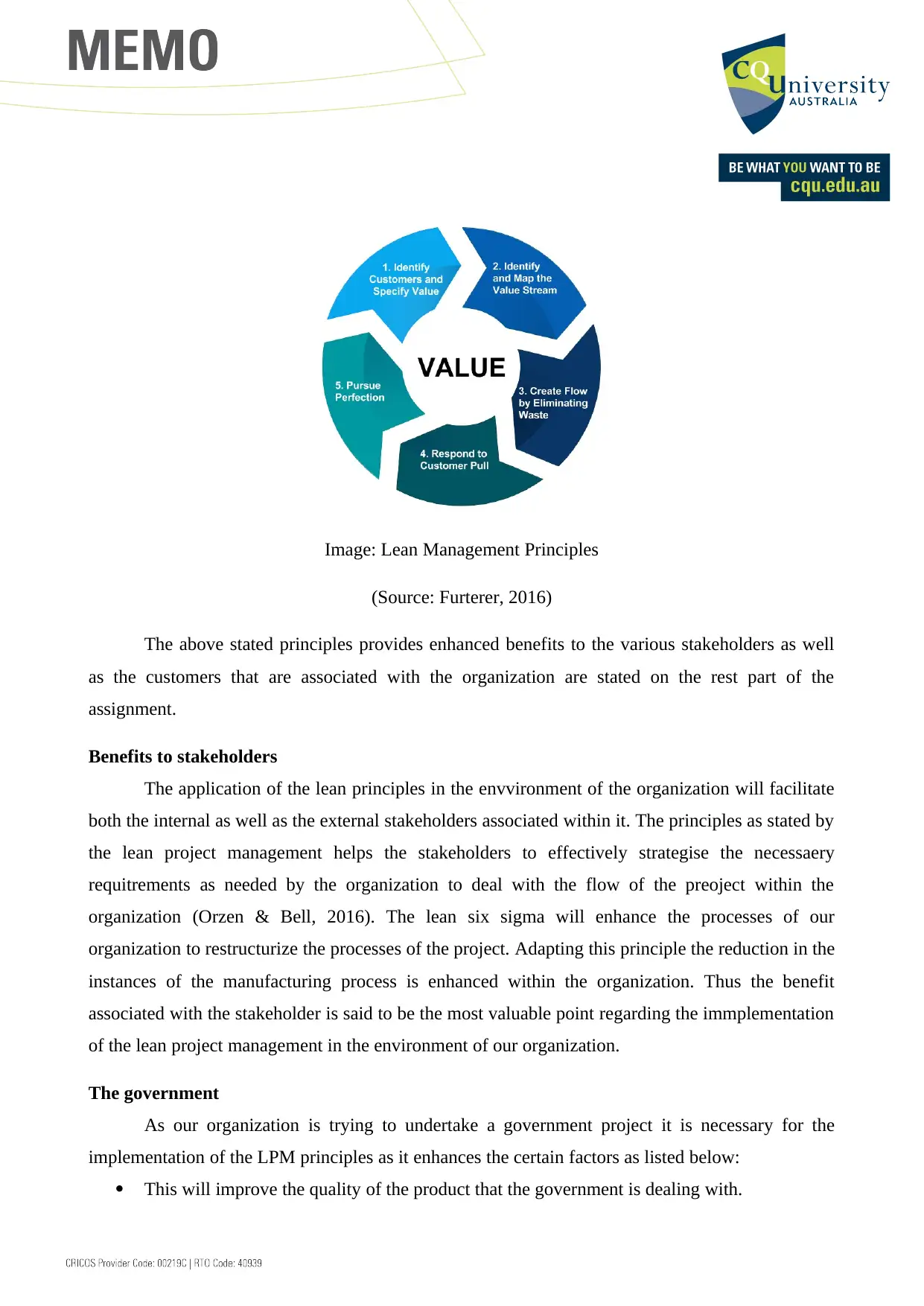
Image: Lean Management Principles
(Source: Furterer, 2016)
The above stated principles provides enhanced benefits to the various stakeholders as well
as the customers that are associated with the organization are stated on the rest part of the
assignment.
Benefits to stakeholders
The application of the lean principles in the envvironment of the organization will facilitate
both the internal as well as the external stakeholders associated within it. The principles as stated by
the lean project management helps the stakeholders to effectively strategise the necessaery
requitrements as needed by the organization to deal with the flow of the preoject within the
organization (Orzen & Bell, 2016). The lean six sigma will enhance the processes of our
organization to restructurize the processes of the project. Adapting this principle the reduction in the
instances of the manufacturing process is enhanced within the organization. Thus the benefit
associated with the stakeholder is said to be the most valuable point regarding the immplementation
of the lean project management in the environment of our organization.
The government
As our organization is trying to undertake a government project it is necessary for the
implementation of the LPM principles as it enhances the certain factors as listed below:
This will improve the quality of the product that the government is dealing with.
(Source: Furterer, 2016)
The above stated principles provides enhanced benefits to the various stakeholders as well
as the customers that are associated with the organization are stated on the rest part of the
assignment.
Benefits to stakeholders
The application of the lean principles in the envvironment of the organization will facilitate
both the internal as well as the external stakeholders associated within it. The principles as stated by
the lean project management helps the stakeholders to effectively strategise the necessaery
requitrements as needed by the organization to deal with the flow of the preoject within the
organization (Orzen & Bell, 2016). The lean six sigma will enhance the processes of our
organization to restructurize the processes of the project. Adapting this principle the reduction in the
instances of the manufacturing process is enhanced within the organization. Thus the benefit
associated with the stakeholder is said to be the most valuable point regarding the immplementation
of the lean project management in the environment of our organization.
The government
As our organization is trying to undertake a government project it is necessary for the
implementation of the LPM principles as it enhances the certain factors as listed below:
This will improve the quality of the product that the government is dealing with.
Paraphrase This Document
Need a fresh take? Get an instant paraphrase of this document with our AI Paraphraser
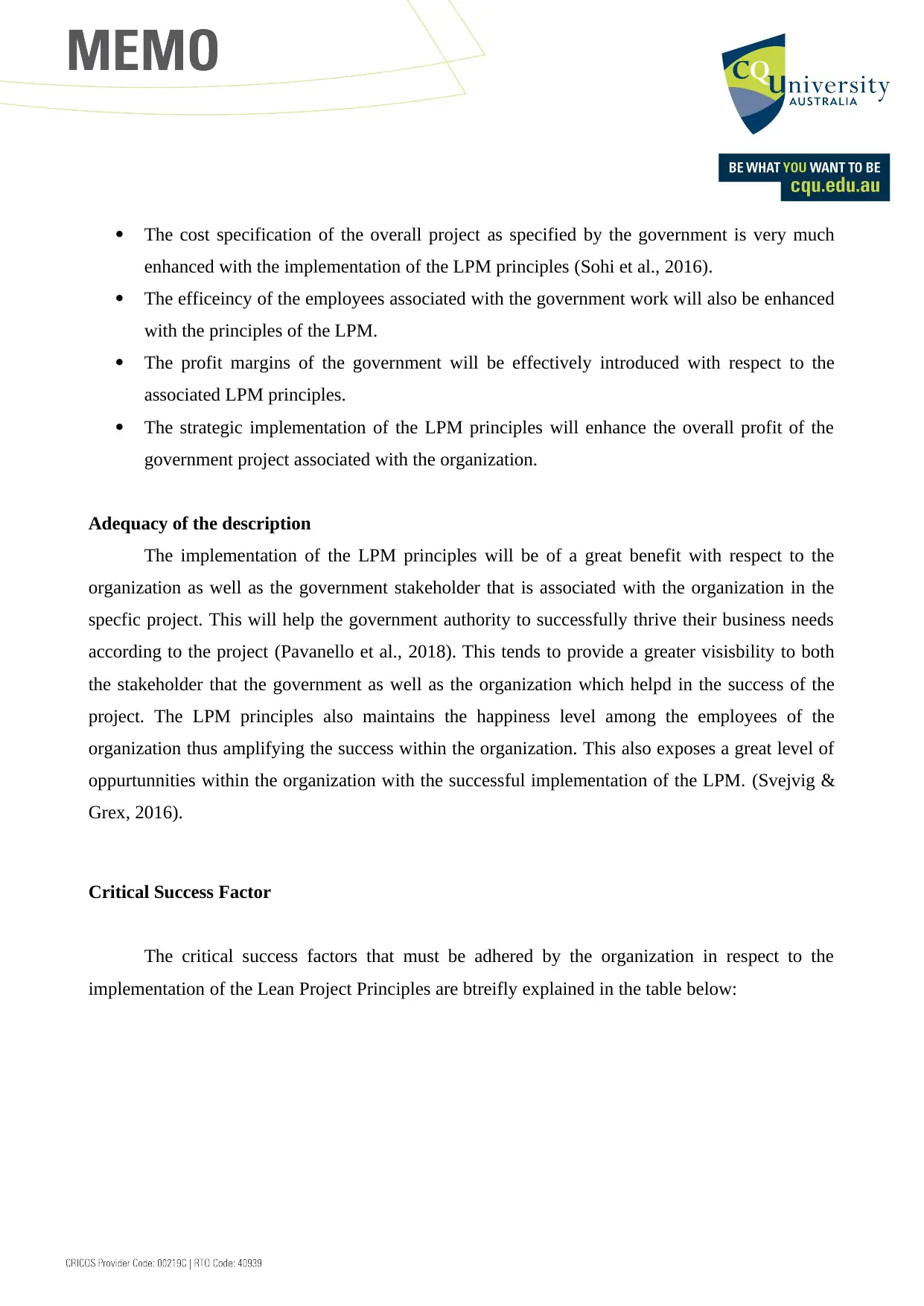
The cost specification of the overall project as specified by the government is very much
enhanced with the implementation of the LPM principles (Sohi et al., 2016).
The efficeincy of the employees associated with the government work will also be enhanced
with the principles of the LPM.
The profit margins of the government will be effectively introduced with respect to the
associated LPM principles.
The strategic implementation of the LPM principles will enhance the overall profit of the
government project associated with the organization.
Adequacy of the description
The implementation of the LPM principles will be of a great benefit with respect to the
organization as well as the government stakeholder that is associated with the organization in the
specfic project. This will help the government authority to successfully thrive their business needs
according to the project (Pavanello et al., 2018). This tends to provide a greater visisbility to both
the stakeholder that the government as well as the organization which helpd in the success of the
project. The LPM principles also maintains the happiness level among the employees of the
organization thus amplifying the success within the organization. This also exposes a great level of
oppurtunnities within the organization with the successful implementation of the LPM. (Svejvig &
Grex, 2016).
Critical Success Factor
The critical success factors that must be adhered by the organization in respect to the
implementation of the Lean Project Principles are btreifly explained in the table below:
enhanced with the implementation of the LPM principles (Sohi et al., 2016).
The efficeincy of the employees associated with the government work will also be enhanced
with the principles of the LPM.
The profit margins of the government will be effectively introduced with respect to the
associated LPM principles.
The strategic implementation of the LPM principles will enhance the overall profit of the
government project associated with the organization.
Adequacy of the description
The implementation of the LPM principles will be of a great benefit with respect to the
organization as well as the government stakeholder that is associated with the organization in the
specfic project. This will help the government authority to successfully thrive their business needs
according to the project (Pavanello et al., 2018). This tends to provide a greater visisbility to both
the stakeholder that the government as well as the organization which helpd in the success of the
project. The LPM principles also maintains the happiness level among the employees of the
organization thus amplifying the success within the organization. This also exposes a great level of
oppurtunnities within the organization with the successful implementation of the LPM. (Svejvig &
Grex, 2016).
Critical Success Factor
The critical success factors that must be adhered by the organization in respect to the
implementation of the Lean Project Principles are btreifly explained in the table below:
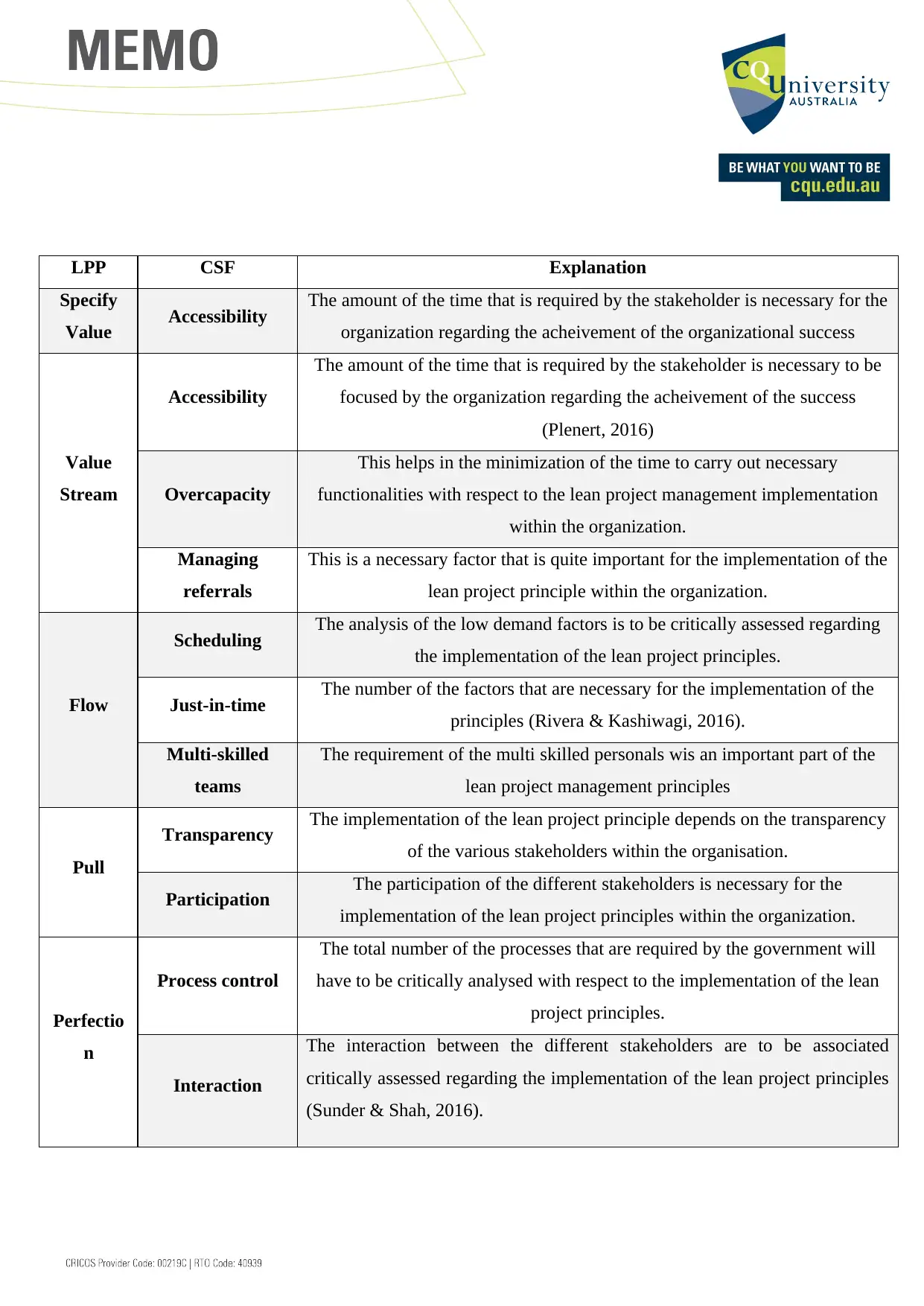
LPP CSF Explanation
Specify
Value Accessibility The amount of the time that is required by the stakeholder is necessary for the
organization regarding the acheivement of the organizational success
Value
Stream
Accessibility
The amount of the time that is required by the stakeholder is necessary to be
focused by the organization regarding the acheivement of the success
(Plenert, 2016)
Overcapacity
This helps in the minimization of the time to carry out necessary
functionalities with respect to the lean project management implementation
within the organization.
Managing
referrals
This is a necessary factor that is quite important for the implementation of the
lean project principle within the organization.
Flow
Scheduling The analysis of the low demand factors is to be critically assessed regarding
the implementation of the lean project principles.
Just-in-time The number of the factors that are necessary for the implementation of the
principles (Rivera & Kashiwagi, 2016).
Multi-skilled
teams
The requirement of the multi skilled personals wis an important part of the
lean project management principles
Pull
Transparency The implementation of the lean project principle depends on the transparency
of the various stakeholders within the organisation.
Participation The participation of the different stakeholders is necessary for the
implementation of the lean project principles within the organization.
Perfectio
n
Process control
The total number of the processes that are required by the government will
have to be critically analysed with respect to the implementation of the lean
project principles.
Interaction
The interaction between the different stakeholders are to be associated
critically assessed regarding the implementation of the lean project principles
(Sunder & Shah, 2016).
Specify
Value Accessibility The amount of the time that is required by the stakeholder is necessary for the
organization regarding the acheivement of the organizational success
Value
Stream
Accessibility
The amount of the time that is required by the stakeholder is necessary to be
focused by the organization regarding the acheivement of the success
(Plenert, 2016)
Overcapacity
This helps in the minimization of the time to carry out necessary
functionalities with respect to the lean project management implementation
within the organization.
Managing
referrals
This is a necessary factor that is quite important for the implementation of the
lean project principle within the organization.
Flow
Scheduling The analysis of the low demand factors is to be critically assessed regarding
the implementation of the lean project principles.
Just-in-time The number of the factors that are necessary for the implementation of the
principles (Rivera & Kashiwagi, 2016).
Multi-skilled
teams
The requirement of the multi skilled personals wis an important part of the
lean project management principles
Pull
Transparency The implementation of the lean project principle depends on the transparency
of the various stakeholders within the organisation.
Participation The participation of the different stakeholders is necessary for the
implementation of the lean project principles within the organization.
Perfectio
n
Process control
The total number of the processes that are required by the government will
have to be critically analysed with respect to the implementation of the lean
project principles.
Interaction
The interaction between the different stakeholders are to be associated
critically assessed regarding the implementation of the lean project principles
(Sunder & Shah, 2016).
⊘ This is a preview!⊘
Do you want full access?
Subscribe today to unlock all pages.

Trusted by 1+ million students worldwide
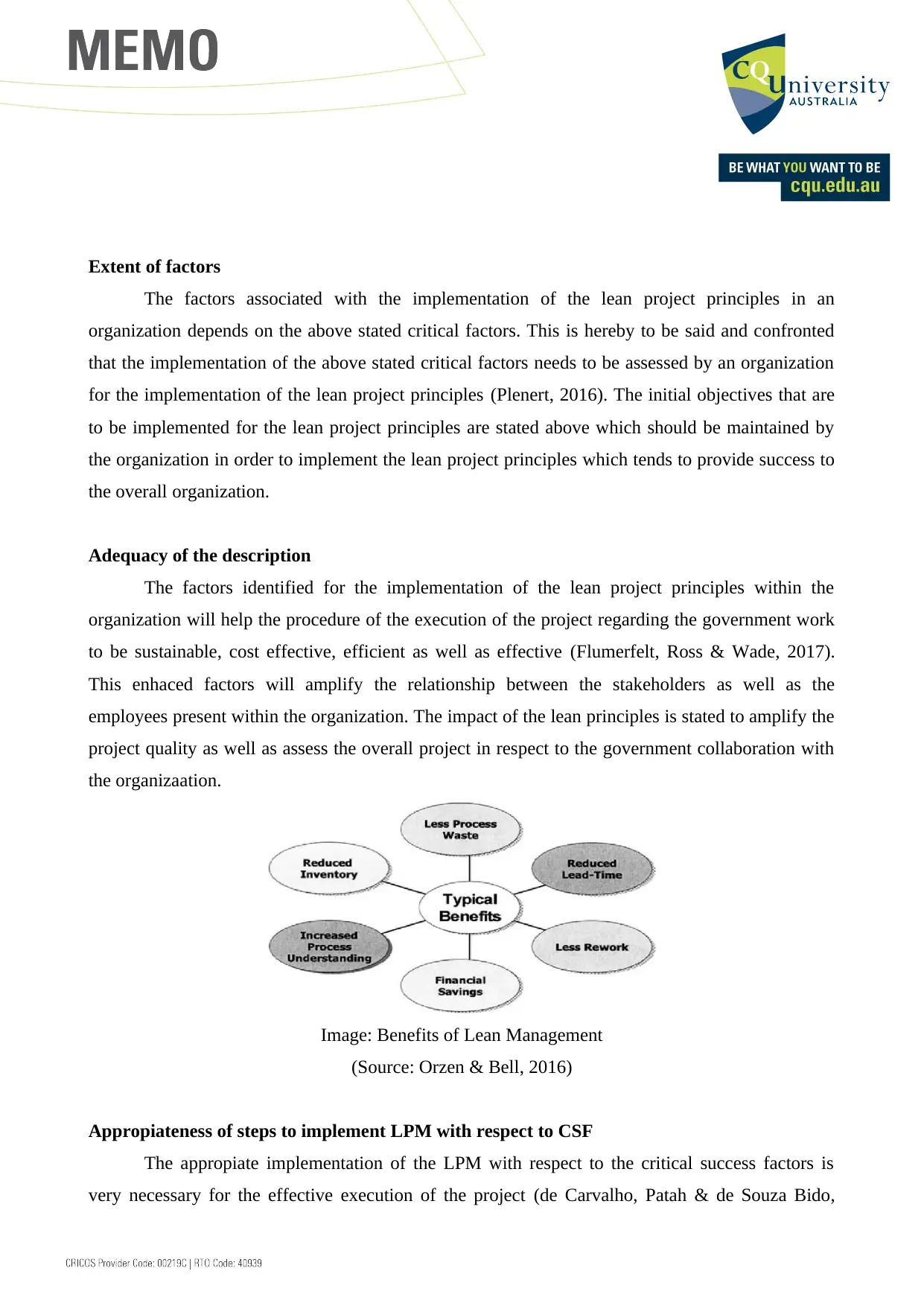
Extent of factors
The factors associated with the implementation of the lean project principles in an
organization depends on the above stated critical factors. This is hereby to be said and confronted
that the implementation of the above stated critical factors needs to be assessed by an organization
for the implementation of the lean project principles (Plenert, 2016). The initial objectives that are
to be implemented for the lean project principles are stated above which should be maintained by
the organization in order to implement the lean project principles which tends to provide success to
the overall organization.
Adequacy of the description
The factors identified for the implementation of the lean project principles within the
organization will help the procedure of the execution of the project regarding the government work
to be sustainable, cost effective, efficient as well as effective (Flumerfelt, Ross & Wade, 2017).
This enhaced factors will amplify the relationship between the stakeholders as well as the
employees present within the organization. The impact of the lean principles is stated to amplify the
project quality as well as assess the overall project in respect to the government collaboration with
the organizaation.
Image: Benefits of Lean Management
(Source: Orzen & Bell, 2016)
Appropiateness of steps to implement LPM with respect to CSF
The appropiate implementation of the LPM with respect to the critical success factors is
very necessary for the effective execution of the project (de Carvalho, Patah & de Souza Bido,
The factors associated with the implementation of the lean project principles in an
organization depends on the above stated critical factors. This is hereby to be said and confronted
that the implementation of the above stated critical factors needs to be assessed by an organization
for the implementation of the lean project principles (Plenert, 2016). The initial objectives that are
to be implemented for the lean project principles are stated above which should be maintained by
the organization in order to implement the lean project principles which tends to provide success to
the overall organization.
Adequacy of the description
The factors identified for the implementation of the lean project principles within the
organization will help the procedure of the execution of the project regarding the government work
to be sustainable, cost effective, efficient as well as effective (Flumerfelt, Ross & Wade, 2017).
This enhaced factors will amplify the relationship between the stakeholders as well as the
employees present within the organization. The impact of the lean principles is stated to amplify the
project quality as well as assess the overall project in respect to the government collaboration with
the organizaation.
Image: Benefits of Lean Management
(Source: Orzen & Bell, 2016)
Appropiateness of steps to implement LPM with respect to CSF
The appropiate implementation of the LPM with respect to the critical success factors is
very necessary for the effective execution of the project (de Carvalho, Patah & de Souza Bido,
Paraphrase This Document
Need a fresh take? Get an instant paraphrase of this document with our AI Paraphraser
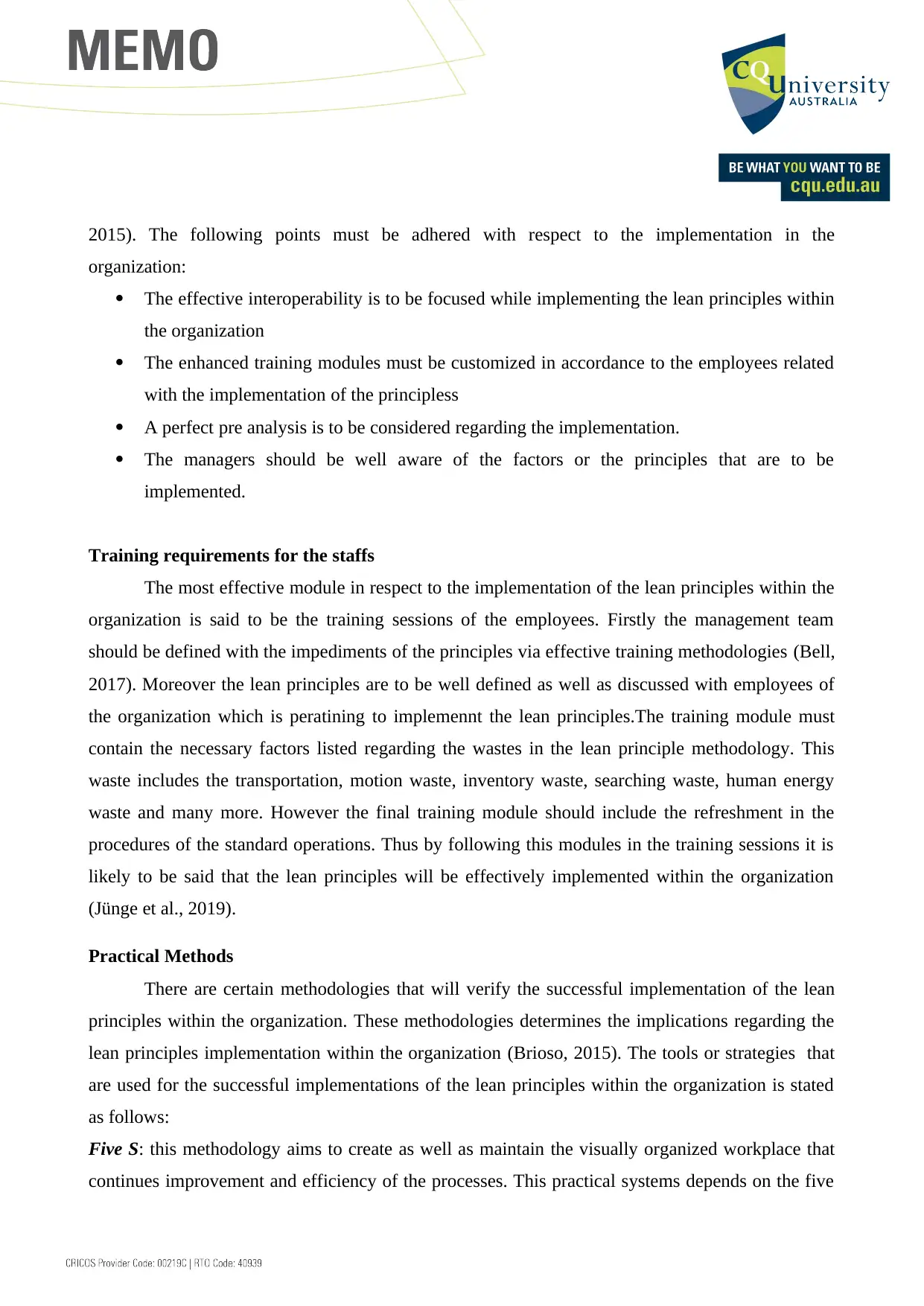
2015). The following points must be adhered with respect to the implementation in the
organization:
The effective interoperability is to be focused while implementing the lean principles within
the organization
The enhanced training modules must be customized in accordance to the employees related
with the implementation of the principless
A perfect pre analysis is to be considered regarding the implementation.
The managers should be well aware of the factors or the principles that are to be
implemented.
Training requirements for the staffs
The most effective module in respect to the implementation of the lean principles within the
organization is said to be the training sessions of the employees. Firstly the management team
should be defined with the impediments of the principles via effective training methodologies (Bell,
2017). Moreover the lean principles are to be well defined as well as discussed with employees of
the organization which is peratining to implemennt the lean principles.The training module must
contain the necessary factors listed regarding the wastes in the lean principle methodology. This
waste includes the transportation, motion waste, inventory waste, searching waste, human energy
waste and many more. However the final training module should include the refreshment in the
procedures of the standard operations. Thus by following this modules in the training sessions it is
likely to be said that the lean principles will be effectively implemented within the organization
(Jünge et al., 2019).
Practical Methods
There are certain methodologies that will verify the successful implementation of the lean
principles within the organization. These methodologies determines the implications regarding the
lean principles implementation within the organization (Brioso, 2015). The tools or strategies that
are used for the successful implementations of the lean principles within the organization is stated
as follows:
Five S: this methodology aims to create as well as maintain the visually organized workplace that
continues improvement and efficiency of the processes. This practical systems depends on the five
organization:
The effective interoperability is to be focused while implementing the lean principles within
the organization
The enhanced training modules must be customized in accordance to the employees related
with the implementation of the principless
A perfect pre analysis is to be considered regarding the implementation.
The managers should be well aware of the factors or the principles that are to be
implemented.
Training requirements for the staffs
The most effective module in respect to the implementation of the lean principles within the
organization is said to be the training sessions of the employees. Firstly the management team
should be defined with the impediments of the principles via effective training methodologies (Bell,
2017). Moreover the lean principles are to be well defined as well as discussed with employees of
the organization which is peratining to implemennt the lean principles.The training module must
contain the necessary factors listed regarding the wastes in the lean principle methodology. This
waste includes the transportation, motion waste, inventory waste, searching waste, human energy
waste and many more. However the final training module should include the refreshment in the
procedures of the standard operations. Thus by following this modules in the training sessions it is
likely to be said that the lean principles will be effectively implemented within the organization
(Jünge et al., 2019).
Practical Methods
There are certain methodologies that will verify the successful implementation of the lean
principles within the organization. These methodologies determines the implications regarding the
lean principles implementation within the organization (Brioso, 2015). The tools or strategies that
are used for the successful implementations of the lean principles within the organization is stated
as follows:
Five S: this methodology aims to create as well as maintain the visually organized workplace that
continues improvement and efficiency of the processes. This practical systems depends on the five
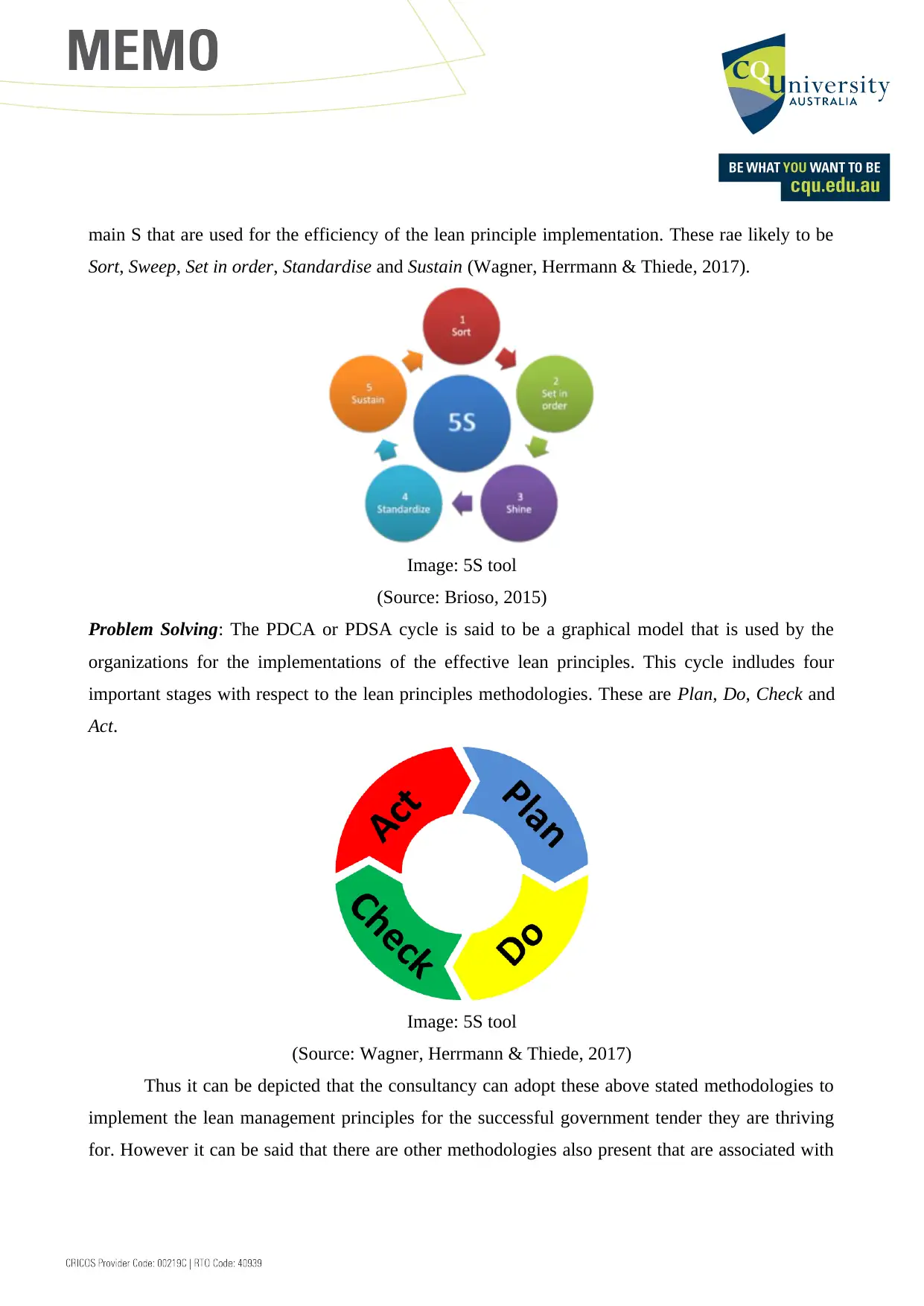
main S that are used for the efficiency of the lean principle implementation. These rae likely to be
Sort, Sweep, Set in order, Standardise and Sustain (Wagner, Herrmann & Thiede, 2017).
Image: 5S tool
(Source: Brioso, 2015)
Problem Solving: The PDCA or PDSA cycle is said to be a graphical model that is used by the
organizations for the implementations of the effective lean principles. This cycle indludes four
important stages with respect to the lean principles methodologies. These are Plan, Do, Check and
Act.
Image: 5S tool
(Source: Wagner, Herrmann & Thiede, 2017)
Thus it can be depicted that the consultancy can adopt these above stated methodologies to
implement the lean management principles for the successful government tender they are thriving
for. However it can be said that there are other methodologies also present that are associated with
Sort, Sweep, Set in order, Standardise and Sustain (Wagner, Herrmann & Thiede, 2017).
Image: 5S tool
(Source: Brioso, 2015)
Problem Solving: The PDCA or PDSA cycle is said to be a graphical model that is used by the
organizations for the implementations of the effective lean principles. This cycle indludes four
important stages with respect to the lean principles methodologies. These are Plan, Do, Check and
Act.
Image: 5S tool
(Source: Wagner, Herrmann & Thiede, 2017)
Thus it can be depicted that the consultancy can adopt these above stated methodologies to
implement the lean management principles for the successful government tender they are thriving
for. However it can be said that there are other methodologies also present that are associated with
⊘ This is a preview!⊘
Do you want full access?
Subscribe today to unlock all pages.

Trusted by 1+ million students worldwide
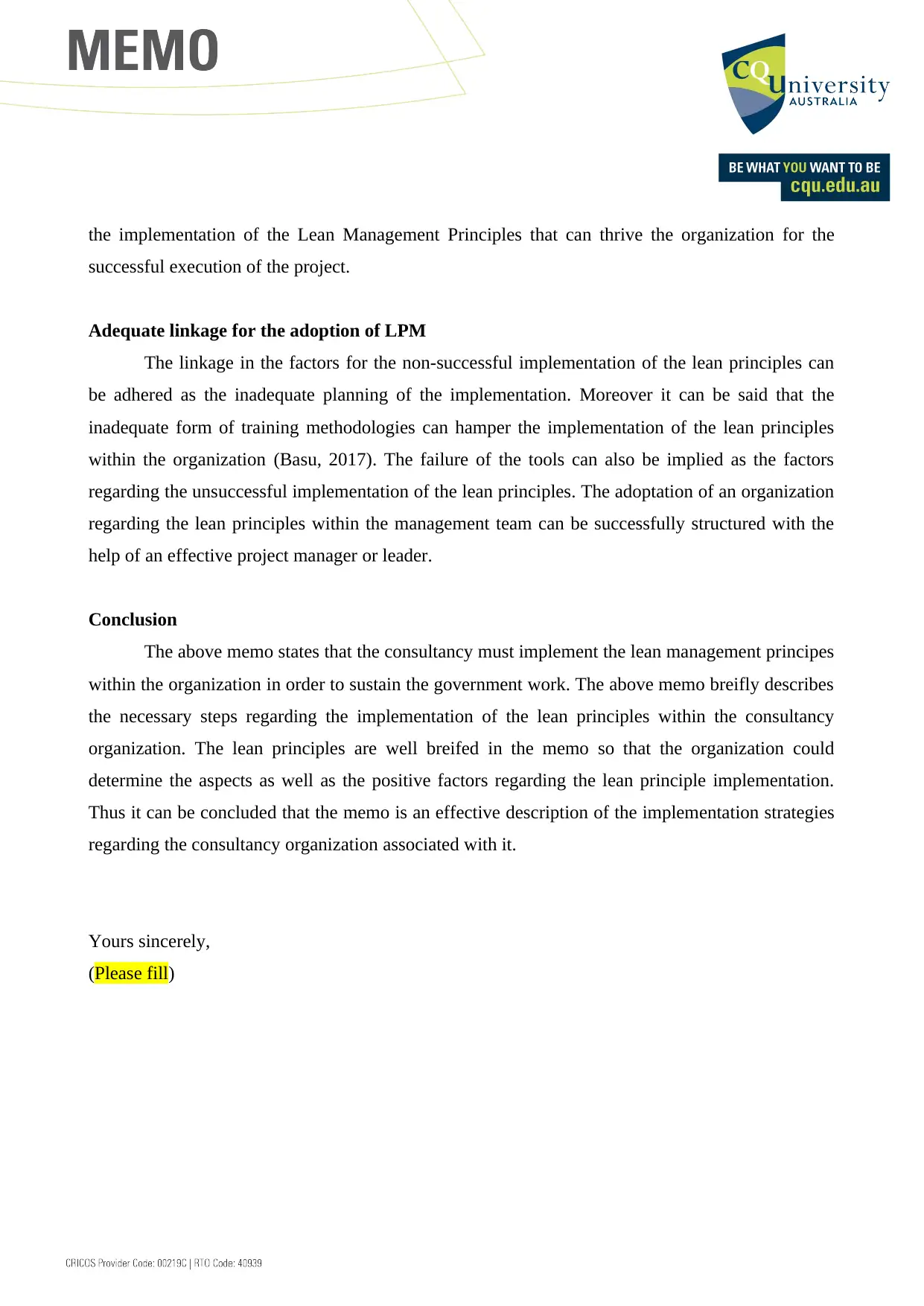
the implementation of the Lean Management Principles that can thrive the organization for the
successful execution of the project.
Adequate linkage for the adoption of LPM
The linkage in the factors for the non-successful implementation of the lean principles can
be adhered as the inadequate planning of the implementation. Moreover it can be said that the
inadequate form of training methodologies can hamper the implementation of the lean principles
within the organization (Basu, 2017). The failure of the tools can also be implied as the factors
regarding the unsuccessful implementation of the lean principles. The adoptation of an organization
regarding the lean principles within the management team can be successfully structured with the
help of an effective project manager or leader.
Conclusion
The above memo states that the consultancy must implement the lean management principes
within the organization in order to sustain the government work. The above memo breifly describes
the necessary steps regarding the implementation of the lean principles within the consultancy
organization. The lean principles are well breifed in the memo so that the organization could
determine the aspects as well as the positive factors regarding the lean principle implementation.
Thus it can be concluded that the memo is an effective description of the implementation strategies
regarding the consultancy organization associated with it.
Yours sincerely,
(Please fill)
successful execution of the project.
Adequate linkage for the adoption of LPM
The linkage in the factors for the non-successful implementation of the lean principles can
be adhered as the inadequate planning of the implementation. Moreover it can be said that the
inadequate form of training methodologies can hamper the implementation of the lean principles
within the organization (Basu, 2017). The failure of the tools can also be implied as the factors
regarding the unsuccessful implementation of the lean principles. The adoptation of an organization
regarding the lean principles within the management team can be successfully structured with the
help of an effective project manager or leader.
Conclusion
The above memo states that the consultancy must implement the lean management principes
within the organization in order to sustain the government work. The above memo breifly describes
the necessary steps regarding the implementation of the lean principles within the consultancy
organization. The lean principles are well breifed in the memo so that the organization could
determine the aspects as well as the positive factors regarding the lean principle implementation.
Thus it can be concluded that the memo is an effective description of the implementation strategies
regarding the consultancy organization associated with it.
Yours sincerely,
(Please fill)
Paraphrase This Document
Need a fresh take? Get an instant paraphrase of this document with our AI Paraphraser

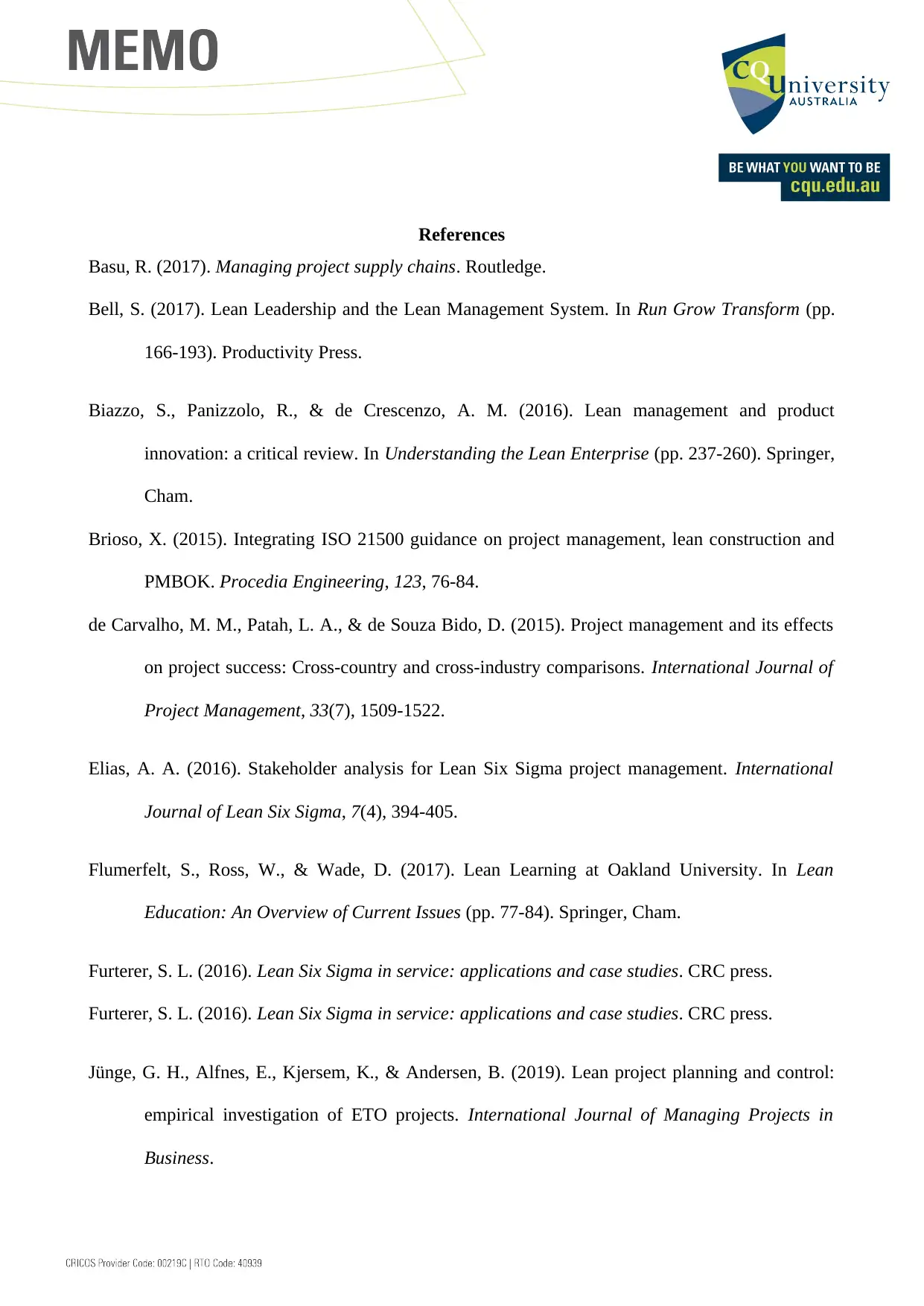
References
Basu, R. (2017). Managing project supply chains. Routledge.
Bell, S. (2017). Lean Leadership and the Lean Management System. In Run Grow Transform (pp.
166-193). Productivity Press.
Biazzo, S., Panizzolo, R., & de Crescenzo, A. M. (2016). Lean management and product
innovation: a critical review. In Understanding the Lean Enterprise (pp. 237-260). Springer,
Cham.
Brioso, X. (2015). Integrating ISO 21500 guidance on project management, lean construction and
PMBOK. Procedia Engineering, 123, 76-84.
de Carvalho, M. M., Patah, L. A., & de Souza Bido, D. (2015). Project management and its effects
on project success: Cross-country and cross-industry comparisons. International Journal of
Project Management, 33(7), 1509-1522.
Elias, A. A. (2016). Stakeholder analysis for Lean Six Sigma project management. International
Journal of Lean Six Sigma, 7(4), 394-405.
Flumerfelt, S., Ross, W., & Wade, D. (2017). Lean Learning at Oakland University. In Lean
Education: An Overview of Current Issues (pp. 77-84). Springer, Cham.
Furterer, S. L. (2016). Lean Six Sigma in service: applications and case studies. CRC press.
Furterer, S. L. (2016). Lean Six Sigma in service: applications and case studies. CRC press.
Jünge, G. H., Alfnes, E., Kjersem, K., & Andersen, B. (2019). Lean project planning and control:
empirical investigation of ETO projects. International Journal of Managing Projects in
Business.
Basu, R. (2017). Managing project supply chains. Routledge.
Bell, S. (2017). Lean Leadership and the Lean Management System. In Run Grow Transform (pp.
166-193). Productivity Press.
Biazzo, S., Panizzolo, R., & de Crescenzo, A. M. (2016). Lean management and product
innovation: a critical review. In Understanding the Lean Enterprise (pp. 237-260). Springer,
Cham.
Brioso, X. (2015). Integrating ISO 21500 guidance on project management, lean construction and
PMBOK. Procedia Engineering, 123, 76-84.
de Carvalho, M. M., Patah, L. A., & de Souza Bido, D. (2015). Project management and its effects
on project success: Cross-country and cross-industry comparisons. International Journal of
Project Management, 33(7), 1509-1522.
Elias, A. A. (2016). Stakeholder analysis for Lean Six Sigma project management. International
Journal of Lean Six Sigma, 7(4), 394-405.
Flumerfelt, S., Ross, W., & Wade, D. (2017). Lean Learning at Oakland University. In Lean
Education: An Overview of Current Issues (pp. 77-84). Springer, Cham.
Furterer, S. L. (2016). Lean Six Sigma in service: applications and case studies. CRC press.
Furterer, S. L. (2016). Lean Six Sigma in service: applications and case studies. CRC press.
Jünge, G. H., Alfnes, E., Kjersem, K., & Andersen, B. (2019). Lean project planning and control:
empirical investigation of ETO projects. International Journal of Managing Projects in
Business.
⊘ This is a preview!⊘
Do you want full access?
Subscribe today to unlock all pages.

Trusted by 1+ million students worldwide
1 out of 14
Related Documents
Your All-in-One AI-Powered Toolkit for Academic Success.
+13062052269
info@desklib.com
Available 24*7 on WhatsApp / Email
![[object Object]](/_next/static/media/star-bottom.7253800d.svg)
Unlock your academic potential
Copyright © 2020–2025 A2Z Services. All Rights Reserved. Developed and managed by ZUCOL.



